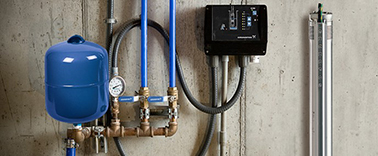Pressure tanks aren’t usually something we give much thought to, but they play a big role in water efficiency. These hidden heroes are part of the system that helps regulate water pressure, making sure it’s just right for everything from your shower to your washing machine.
By maintaining steady pressure, pressure tanks reduce the wear and tear on your plumbing, saving water, energy, and ultimately, your wallet. They keep your system running smoothly without the ups and downs of fluctuating pressure, ensuring you don’t waste water when it’s not needed. It’s a simple but effective way to make your home’s water system more efficient.
How do pressure tanks improve water efficiency in a home?
Pressure tanks improve water efficiency in a home by maintaining consistent water pressure, which reduces the need for the pump to run constantly. Here’s how they work:
- Constant Pressure: Pressure tanks store water under pressure, ensuring a steady flow when you turn on a faucet or use appliances. This eliminates fluctuations in water pressure, providing a reliable and consistent water supply without overloading the system.
- Reduced Pump Cycling: Pressure tanks store water in the tank, reducing the frequency with which the pump needs to cycle on and off. This saves energy and prevents unnecessary wear and tear on the pump, increasing its lifespan and reducing the frequency of costly repairs.
- Efficient Water Use: Water is readily available with pressure tanks, reducing wait times and ensuring that multiple fixtures can operate simultaneously without diminishing water flow or pressure. This efficiency leads to less wasted water and energy.
Pressure tanks optimize water delivery by reducing pump usage and providing consistent pressure, ultimately improving overall home water efficiency.
What role do pressure tanks play in maintaining consistent water pressure?
Pressure tanks play a vital role in maintaining consistent water pressure by acting as a buffer between the water pump and the plumbing system. Here’s how they work:
- Storing Pressurized Water: The pressure tank stores water under pressure, making it readily available when you turn on a faucet or use an appliance. As water is drawn from the system, the tank releases stored water, ensuring that water pressure remains stable and consistent, even during periods of high demand.
- Minimizing Pump Cycles: Without a pressure tank, the water pump would need to turn on every time water is needed, leading to frequent cycling. This constant on-and-off operation can cause pressure fluctuations and strain the pump unnecessarily. The pressure tank helps prevent this by maintaining the required pressure in the system, reducing the pump’s workload, and maintaining steady water pressure.
Pressure tanks store water and maintain consistent pressure in the system, preventing fluctuations and ensuring reliable water flow while reducing energy consumption and wear on the pump.
Why is a properly sized pressure tank important for reducing water waste?
A properly sized pressure tank is crucial for reducing water waste because it ensures efficient water system operation, balancing the need for consistent pressure with minimal pump usage. Here’s why sizing is so important:
- Optimal Water Storage: If a pressure tank is too small, the pump will cycle on and off more frequently to maintain water pressure, leading to wasteful energy consumption and unnecessary wear on the system. Conversely, a pressure tank that’s too large may store excessive water, which also wastes space and could result in less efficient energy use. Proper sizing ensures the tank stores enough water to meet demand without excessive pressure or short cycling, reducing water waste.
- Reduced Pump Cycling: A correctly sized tank allows the water pump to run longer without turning on and off frequently. Fewer cycles mean less water is wasted due to constant pressure fluctuations, and the system operates more efficiently. This means the pump doesn’t have to overwork, reducing energy consumption and preventing water wastage caused by inefficient water delivery.
A properly sized pressure tank ensures that water is used effectively, the system operates efficiently, and excess water is not wasted, leading to long-term savings in water and energy.
How does a pressure tank help extend the lifespan of a well pump?
A pressure tank helps extend the lifespan of a well pump by reducing the frequency of pump cycles and minimizing the strain on the pump. Here’s how it works:
- Reduced Cycling: Without a pressure tank, the pump would need to turn on and off every time water is used, leading to frequent cycling. This constant activation and deactivation puts significant stress on the pump, which can lead to premature wear and failure. The pressure tank acts as a buffer, storing water under pressure so that the pump only needs to turn on when the pressure drops below a certain level, reducing the number of cycles and prolonging the pump’s life.
- Maintaining Steady Pressure: The pressure tank ensures consistent water pressure, preventing fluctuations when the pump cycles too frequently. This constant pressure helps maintain smooth operation, reducing the risk of damage to the pump and the plumbing system.
- Energy Efficiency: Since the pump isn’t constantly running, it operates more efficiently, consuming less energy and reducing the likelihood of overheating or malfunctioning. This efficiency contributes to the pump’s overall longevity.
A pressure tank helps by reducing pump wear and tear, ensuring consistent operation, and improving energy efficiency, all of which extend the lifespan of a well pump.
Boost Water Efficiency with Proper Pressure Tank Maintenance
At Well Doctor LLC, we understand pressure tanks’ crucial role in maintaining consistent water pressure and improving overall water efficiency. Properly maintaining your pressure tank ensures your water system operates smoothly, reducing unnecessary pump cycling and minimizing energy consumption.
Regular maintenance helps extend the life of your well pump, prevent water waste, and improve system performance. Contact us today for expert pressure tank maintenance and ensure your system runs at its best.

